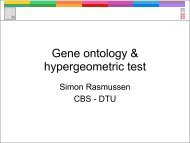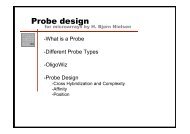Computational tools and Interoperability in Comparative ... - CBS
Computational tools and Interoperability in Comparative ... - CBS
Computational tools and Interoperability in Comparative ... - CBS
You also want an ePaper? Increase the reach of your titles
YUMPU automatically turns print PDFs into web optimized ePapers that Google loves.
3106 Nucleic Acids Research, 2007, Vol. 35, No. 9<br />
Table 3. Evaluation of spotter <strong>and</strong> full model predictions.<br />
K<strong>in</strong>gdom Type Number of model predictions Full model scores T99 Pm<strong>in</strong><br />
correspond<strong>in</strong>g rRNAs, we consider rRNA sequences to be<br />
unlikely to extend beyond these w<strong>in</strong>dows.<br />
<strong>Computational</strong> speed<br />
Search<strong>in</strong>g Mycoplasma capricolum ATCC27343, about<br />
1 Mbp, for bacterial 16S took 14 m<strong>in</strong>utes us<strong>in</strong>g the full<br />
HMM. Us<strong>in</strong>g the spotter to screen the sequence, then the<br />
full model on the spotter hits, reduced the time to<br />
16 seconds. Search times are expected to <strong>in</strong>crease<br />
proportionally to the genome size; when us<strong>in</strong>g the spotter<br />
model to screen the sequence, search time will also<br />
<strong>in</strong>crease with <strong>in</strong>creas<strong>in</strong>g number of spotter hits.<br />
Time differences between search<strong>in</strong>g long <strong>and</strong> short<br />
sequences were exam<strong>in</strong>ed by search<strong>in</strong>g through the<br />
complete sequence of Solibacter usitatus Ell<strong>in</strong>6076, <strong>and</strong><br />
through the Sargasso Sea environmental samples (19).<br />
Search<strong>in</strong>g the S. usitatus genome, about 10 Mbp, took 48<br />
seconds per Mbp. Two copies from each rRNAs family<br />
were found. The Sargasso Sea samples consisted of<br />
811 372 entries total<strong>in</strong>g over 800 Mbp. On this set the<br />
search speed was 407 seconds per Mbp. The article (19)<br />
accompany<strong>in</strong>g this set <strong>in</strong>dicated 1164 small subunit rRNA<br />
genes (16/18S) or fragments of genes; we found only 332,<br />
but our predictors are not able to f<strong>in</strong>d fragments of<br />
rRNAs. In addition, we found 562 5S <strong>and</strong> 68 23S<br />
sequences.<br />
DISCUSSION<br />
Full Spotter FPS M<strong>in</strong> Q1 Med Q3 Max<br />
Archaea 5S 47 35 7 2.9 12.7 20.0 35.3 50.6 34.9 0.69<br />
16S 47 47 0 1180.8 1891.9 1937.9 2004.0 2096.5 50 1.0<br />
23S 46 46 1 2240.7 2714.1 2870.7 3155.3 3267.3 50 1.0<br />
Bacteria 5S 1339 1339 123 39.9 77.7 89.5 94.6 109.6 14.0 1.0<br />
16S 1237 1237 31 721.9 1905.5 1989.4 2058.7 2148.5 50 1.0<br />
23S 1248 1248 20 2502.8 3267.8 3586.5 3690.7 3876.1 50 1.0<br />
Eukaryotes 5S 324 324 251 43.9 51.1 53.9 74.3 82.2 50 1.0<br />
18S 13 13 14 625.3 625.3 1733.1 1777.5 1777.6 50 1.0<br />
28S 19 19 5 1434.2 2904.7 3225.0 3335.9 3380.9 50 1.0<br />
This table shows the total number of full models, the number of spotter predictions that had match<strong>in</strong>g full model predictions <strong>and</strong> the number of false<br />
positive spotter model predictions. The characteristics of the full model prediction score distributions are shown. FPS denotes the number of false<br />
positive spotter predictions. T99 refers to the lowest score a full model could have while still be<strong>in</strong>g detected with 99% probability by a spotter model<br />
with positive score. Pm<strong>in</strong> is the probability that a spotter with positive score would f<strong>in</strong>d a full model with the m<strong>in</strong>imum score <strong>in</strong>dicated. The lowest<br />
score for a full model score can be used as a lower limit on which results could be expected to be real.<br />
Our aim has been to enable high-throughput searches for<br />
rRNA while produc<strong>in</strong>g accurate <strong>and</strong> consistent predictions<br />
suitable for comparative analyses. For this purpose,<br />
we have developed the RNAmmer package which relies on<br />
HMMs for both speed <strong>and</strong> accuracy. HMMs were made<br />
us<strong>in</strong>g HMMer (15), which from a multiple alignment<br />
produces an HMM where match states represent columns<br />
with a specific nucleotide distribution, correspond<strong>in</strong>g<br />
deletion states represent the possibility of gaps, <strong>and</strong><br />
<strong>in</strong>sertion states represent columns with large numbers of<br />
gaps; transition probabilities between the states <strong>in</strong>dicate<br />
how likely each of the states are. HMMs thus differ from<br />
sequence alignments <strong>in</strong> that the likelihood of <strong>in</strong>sertions<br />
<strong>and</strong> deletions may vary along the sequence. When<br />
search<strong>in</strong>g a sequence with an HMM, the score <strong>in</strong>dicates<br />
how well the sequence segment matches the model. The<br />
<strong>in</strong>formation content of a position, which reflects the<br />
nucleotide distribution <strong>and</strong> the likelihood of gaps,<br />
<strong>in</strong>dicates how well that position is conserved. A good<br />
match to the HMM may come either from a highly<br />
conserved region which may well be short, or from a<br />
longer region with only weak conservation. We f<strong>in</strong>d both<br />
these cases. Bacterial 16S are detected despite almost half<br />
of the nucleotides be<strong>in</strong>g assigned to <strong>in</strong>sert states, as other<br />
regions are highly conserved. For archaeal 23S, however,<br />
the <strong>in</strong>formation content of each position is low, but the<br />
sequence is long <strong>and</strong> there are few allowed <strong>in</strong>sert states.<br />
These aspects can also expla<strong>in</strong> cases of poor performance,<br />
both of the full model <strong>and</strong> of the spotter model.<br />
The low <strong>in</strong>formation content <strong>in</strong> the eukaryotic 5S <strong>and</strong><br />
18S alignments <strong>in</strong>dicates that these sequences are more<br />
divergent than archaeal <strong>and</strong> bacterial 5S <strong>and</strong> 16S.<br />
In addition, 40% of the 5S <strong>and</strong> 75% of the 18S alignment<br />
give rise to <strong>in</strong>sert states <strong>in</strong> the HMM. Thus, there is little<br />
for the HMM to recognize. In addition, many of the<br />
missed 18S rRNAs were from Cryptophyta, a phylum<br />
which makes up only 0.6% of the alignment data.<br />
The archaeal 5S show the same characteristics as the<br />
eukaryotic 5S <strong>and</strong> 18S, which most likely expla<strong>in</strong>s the low<br />
performance for these rRNAs. The score for archaeal 5S<br />
hits were generally low, <strong>and</strong> the spotter score comes only<br />
from a 75 nt part of the sequence giv<strong>in</strong>g it even lower score<br />
caus<strong>in</strong>g it to miss 12 of the full model hits. It is notable,<br />
however, that these were the only cases missed by the<br />
spotter model: with the exception of archaeal 5S, our<br />
analyses show that the spotter should be able to detect<br />
rRNAs unless they are much further diverged than what<br />
we f<strong>in</strong>d <strong>in</strong> our data.<br />
Columns at the beg<strong>in</strong>n<strong>in</strong>g <strong>and</strong> end of the multiple<br />
alignments often have low conservation <strong>and</strong> many gaps.<br />
Such columns are generally accommodated <strong>in</strong>to the<br />
HMM as <strong>in</strong>sert states, but HMMer ignores them at the<br />
beg<strong>in</strong>n<strong>in</strong>g <strong>and</strong> end of the alignment. An example is the 5S,









